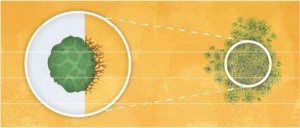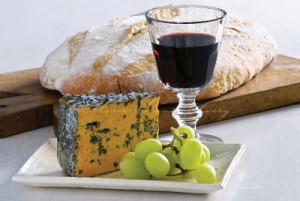MOLD. Friend or Foe?

By Shelagh Duncan
What is Mold?
Molds (and mildew) are fungi. Fungi are not plant, animal or bacteria, they are microbial. They are responsible for such wonderful organisms as the delicious edible mushrooms, they are the makers of the “miracle drug” penicillin and the yeast that makes our bread rise, our fine wines ferment and our richly flavoured cheeses taste so good. They play important roles in bio-technology and food science in the production of many foods, beverages, antibiotics and enzymes.
Biologically, all fungi have defined cell walls, lack chlorophyll and reproduce by means of (airborne) spores. Approximately 100,000 species of fungi have been described and it is estimated that there are at least that many waiting to be discovered. The vast majority of fungi feed on dead or decaying organic matter – they are one of the principle agents responsible for the natural recycling of dead plant and animal life(1).
That is the problem. We live in the jungle, in the tropics, and all around us the cycle of life is renewing itself constantly and producing countless numbers of spores that we breathe in and live with each day. Some of these cause allergies and can have serious health issues, most are just a constant cleaning problem.

Mold has four critical requirements for growth – available mold spores, available mold food, appropriate temperatures and considerable moisture. In other words, if we can control our environment, we can control mold. Easier said than done.
Air conditioning and dehumidifiers will help with the temperature and humidity requirements, but it is impossible to eliminate the spores, or their food. Almost every substance that contains carbon atoms (organic substances) will provide food – and carbon is everywhere. It is the sixth most abundant element in the universe(2). The oil from your skin that is left when you touch an otherwise mold resistant surface like stainless steel, or the soap residue left from a good cleaning will both provide sufficient nutrients to support the growth of most molds. Once a spore finds food it attaches itself, puts out roots and quickly colonizes the area.
If you have used bleach you will see that the mold always returns, usually even worse than before, especially on porous surfaces. Although it eliminates the visible mold growth, it also encourages the next bloom. Bleach is 99% water, and when it dries it leaves a layer of carbon residue behind – which is the perfect mold food.
Also, many of the most common materials found in homes like wood, fabric and other organic fibers are among the most preferred of mold nutrients. So, eliminating mold food from your environment is a virtually impossible task.
What can you do about it?
It has been suggested that anti-fungal, oil based paint works to deter mold growth, and we tried it and agree. Builders here typically use water based paints because they are cheaper and easier to work with. Even with the anti-fungal paint (oil or water based) the mold will still grow on the surface if you don’t keep it clean. It grows on almost everything – even specs of dust!
The Ozone Shock Treatments have become more popular recently as a fast and easy solution to get rid of moldy smells in homes. This method blasts the area with a lethal dose of ozone. As long as you evacuate and wait until it has dissipated, it is safe enough for humans. Critics however, say it may kill, but does not remove the mold, and as this high-ozone dose is a powerful oxidizing agent, the ozone could not only damage such things as rubber, it could also actually change the molecular structure of some chemicals to produce other noxious chemicals. (3)
There many other studies that do confirm the effective use of ozone to kill mold, but in conjunction with other remediation techniques.

Stay away from using drywall or any other porous building materials if you can. Concrete ideally should be sealed, because moisture wicks up from foundations and through block walls. Slabs should be poured onto a thick layer of plastic over a couple of inches of raked sand. Any other kind of moisture-block applied to exterior masonry surfaces is also recommended. Sella Tek SA is a Costa Rican company specializing in sealing buildings against moisture problems.
Running hot water pipes through the house is a smart and practical solution for drying closets and storage areas, and locating your water heater in a bodega (or large closet) will give you a ‘dry’ room. Adding a light bulb inside a kitchen pantry will help keep it dry. Also finishing your wood and bamboo with polyurethane, instead of shellac, will work well – however marine varnish will out-perform all others. Use car wax along your grout lines to help prevent the moisture seeping up from the concrete below, and especially in showers or anywhere it comes in direct contact with water. Auto wax is also great to use on appliances once or twice a year to prevent rust!
We know that bleach is a no-no. Vinegar kills bacteria and germs, but only some types of mold. Also, any vinegar you buy here is pretty diluted – so again it is almost all water…. Mixing it with borax (not boric acid which is highly toxic) will improve results.
You can use natural anti-microbial cleaners like Concrobium Mold Control on almost everything including fabric. It really works with a treatment just once or twice a year. This is a natural, safe product that actually kills the mold right down to the ‘roots’ by suffocating it. The magic is that once dry it sets up an anti-microbial barrier or shield, to prevent other spores settling and growing in the treated area. Odour and chemical-free it is easy to use and very effective.(4)
For mattresses and thick cushions – go Tico. Put them outside in the sun, and turn them often. Make use of solar power. Elevated or propped up on a concrete surface, they will heat up faster than on gravel or earth. When dry, spray with Mold Control to keep the musty smells at bay.
Obvious things like running your fans and maximizing ventilation will increase the air circulation in your house, but unfortunately the most effective, overall solution is still air conditioners and dehumidifiers; or a combination of all of the above.

Some of us have come to the conclusion that no matter how hard we try, we just have to live with ubiquitous mold and the constant battle to keep one-step-ahead. So pour yourself a glass of fine wine, cut a slice of crusty fresh bread, layer on some Blue Stilton, sit back and enjoy. Salud!
Paradise has its price – and it’s rewards.
Until next time…
Shelagh Duncan
(2) Math & Science Activity Center
(3) wikipedia.org/wiki/High-ozone_shock_treatment
Concrobium Mold Control is available at Royal Palm Interiors in Uvita.

